Search
- Page Path
- HOME > Search
- [English]
- Optimization of VIGA Process Parameters for Power Characteristics of Fe-Si-Al-P Soft Magnetic Alloy using Machine Learning
- Sung-Min Kim, Eun-Ji Cha, Do-Hun Kwon, Sung-Uk Hong, Yeon-Joo Lee, Seok-Jae Lee, Kee-Ahn Lee, Hwi-Jun Kim
- J Powder Mater. 2022;29(6):459-467. Published online December 1, 2022
- DOI: https://doi.org/10.4150/KPMI.2022.29.6.459

- 734 View
- 13 Download
-
 Abstract
Abstract
 PDF
PDF Soft magnetic powder materials are used throughout industries such as motors and power converters. When manufacturing Fe-based soft magnetic composites, the size and shape of the soft magnetic powder and the microstructure in the powder are closely related to the magnetic properties. In this study, Fe-Si-Al-P alloy powders were manufactured using various manufacturing process parameter sets, and the process parameters of the vacuum induction melt gas atomization process were set as melt temperature, atomization gas pressure, and gas flow rate. Process variable data that records are converted into 6 types of data for each powder recovery section. Process variable data that recorded minute changes were converted into 6 types of data and used as input variables. As output variables, a total of 6 types were designated by measuring the particle size, flowability, apparent density, and sphericity of the manufactured powders according to the process variable conditions. The sensitivity of the input and output variables was analyzed through the Pearson correlation coefficient, and a total of 6 powder characteristics were analyzed by artificial neural network model. The prediction results were compared with the results through linear regression analysis and response surface methodology, respectively.
- [Korean]
- The Effects of TiC Content on Microstructure of Modified A6013-3wt.%Si Alloy Powder Compact
- Hyo-Sang Yoo, Yong-Ho Kim, Hyeon-Taek Son
- J Powder Mater. 2022;29(1):28-33. Published online February 1, 2022
- DOI: https://doi.org/10.4150/KPMI.2022.29.1.28

- 813 View
- 5 Download
- 1 Citations
-
 Abstract
Abstract
 PDF
PDF Aluminum-based powders have attracted attention as key materials for 3D printing owing to their low density, high specific strength, high corrosion resistance, and formability. This study describes the effects of TiC addition on the microstructure of the A6013 alloy. The alloy powder was successfully prepared by gas atomization and further densified using an extrusion process. We have carried out energy dispersive X-ray spectrometry (EDS) and electron backscatter diffraction (EBSD) using scanning electron microscopy (SEM) in order to investigate the effect of TiC addition on the microstructure and texture evolution of the A6013 alloy. The atomized A6013-xTiC alloy powder is fine and spherical, with an initial powder size distribution of approximately 73 μm which decreases to 12.5, 13.9, 10.8, and 10.0 μm with increments in the amount of TiC.
-
Citations
Citations to this article as recorded by- Influence of Curing Agent Amount on Properties of Dynamic Vulcanized Phenyl Silicone Rubber-SEBS-SBS System
Chunxu Zhao, Bobing He, Xian Chen
Polymers.2022; 14(24): 5443. CrossRef
- Influence of Curing Agent Amount on Properties of Dynamic Vulcanized Phenyl Silicone Rubber-SEBS-SBS System
- [Korean]
- Study on the Compaction Properties of Fe-Si-Al-Graphite Powder Mixtures
- Jun Hyeok Jeong, Jinnil Choi
- J Korean Powder Metall Inst. 2020;27(4):300-304. Published online August 1, 2020
- DOI: https://doi.org/10.4150/KPMI.2020.27.4.300
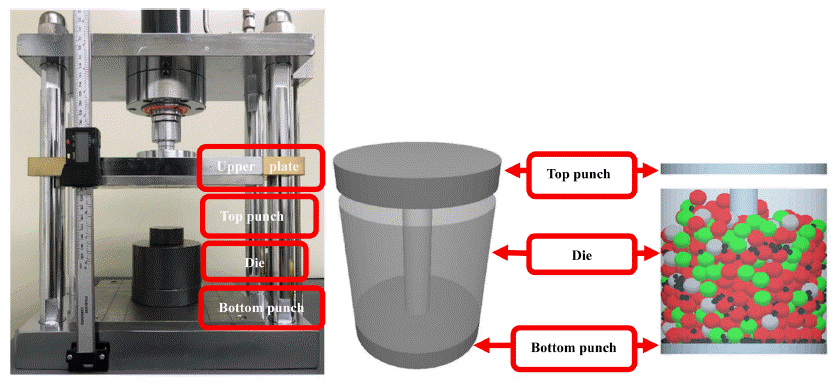
- 465 View
- 3 Download
-
 Abstract
Abstract
 PDF
PDF In this paper, a durability study is presented to enhance the mechanical properties of an Fe-Si-Al powderbased magnetic core, through the addition of graphite. The compressive properties of Fe-Si-Al-graphite powder mixtures are explored using discrete element method (DEM), and a powder compaction experiment is performed under identical conditions to verify the reliability of the DEM analysis. Important parameters for powder compaction of Fe-Si-Algraphite powder mixtures are identified. The compressibility of the powders is observed to increase as the amount of graphite mixture increases and as the size of the graphite powders decreases. In addition, the compaction properties of the Fe-Si-Al-graphite powder mixtures are further explored by analyzing the transmissibility of stress between the top and bottom punches as well as the distribution of the compressive force. The application of graphite powders is confirmed to result in improved stress transmission and compressive force distribution, by 24% and 51%, respectively.
- [Korean]
- Recent Development in Performance Enhancement of PVDF-Nanopowder Composite-based Energy Harvesting Devices
- Geon-Ju Choi, Il-Kyu Park
- J Korean Powder Metall Inst. 2020;27(3):247-255. Published online June 1, 2020
- DOI: https://doi.org/10.4150/KPMI.2020.27.3.247
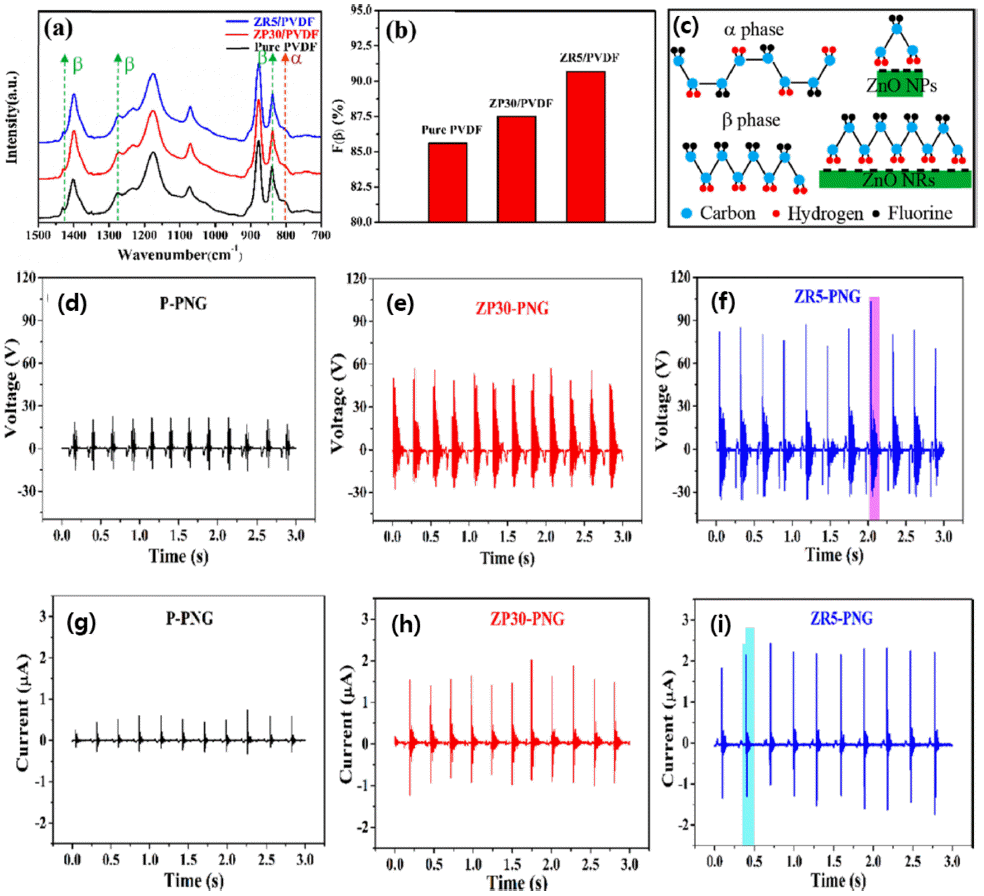
- 959 View
- 11 Download
-
 Abstract
Abstract
 PDF
PDF Recently, interest in technology for eco-friendly energy harvesting has been increasing. Polyvinylidene fluoride (PVDF) is one of the most fascinating materials that has been used in energy harvesting technology as well as micro-filters by utilizing an electrostatic effect. To enhance the performance of the electrostatic effect-based nanogenerator, most studies have focused on enlarging the contact surface area of the pair of materials with different triboelectric series. For this reason, one-dimensional nanofibers have been widely used recently. In order to realize practical energy-harvesting applications, PVDF nanofibers are modified by enlarging their contact surface area, modulating the microstructure of the surface, and maximizing the fraction of the β-phase by incorporating additives or forming composites with inorganic nanoparticles. Among them, nanocomposite structures incorporating various nanoparticles have been widely investigated to increase the β-phase through strong hydrogen bonding or ion-dipole interactions with -CF2/CH2- of PVDF as well as to enhance the mechanical strength. In this study, we report the recent advances in the nanocomposite structure of PVDF nanofibers and inorganic nanopowders.
- [Korean]
- Investigation on Interfacial Microstructures of Stainless Steel/Inconel Bonded by Directed Energy Deposition of alloy Powders
- Yeong Seong Eom, Kyung Tae Kim, Soo-Ho Jung, Jihun Yu, Dong Yeol Yang, Jungho Choe, Chul Yong Sim, Seung Jun An
- J Korean Powder Metall Inst. 2020;27(3):219-225. Published online June 1, 2020
- DOI: https://doi.org/10.4150/KPMI.2020.27.3.219

- 1,496 View
- 4 Download
- 1 Citations
-
 Abstract
Abstract
 PDF
PDF The directed energy deposition (DED) process of metal 3D printing technologies has been treated as an effective method for welding, repairing, and even 3-dimensional building of machinery parts. In this study, stainless steel 316L (STS316L) and Inconel 625 (IN625) alloy powders are additively manufactured using the DED process, and the microstructure of the fabricated STS316L/IN625 sample is investigated. In particular, there are no secondary phases in the interface between STS316L and the IN625 alloy. The EDS and Vickers hardness results clearly show compositionally and mechanically transient layers a few tens of micrometers in thickness. Interestingly, several cracks are only observed in the STS 316L rather than in the IN625 alloy near the interface. In addition, small-sized voids 200–400 nm in diameter that look like trapped pores are present in both materials. The cracks present near the interface are formed by tensile stress in STS316L caused by the difference in the CTE (coefficient of thermal expansion) between the two materials during the DED process. These results can provide fundamental information for the fabrication of machinery parts that require joining of two materials, such as valves.
-
Citations
Citations to this article as recorded by- Microstructures and mechanical properties of 316LSi/IN625 FGMs manufactured by CMT-WAAM
Jiang Aimin, Ahmad Baharuddin Abdullah, Shahir Mohd Yusuf
Advances in Mechanical Engineering.2025;[Epub] CrossRef
- Microstructures and mechanical properties of 316LSi/IN625 FGMs manufactured by CMT-WAAM
- [Korean]
- Synthesis of Porous Cu-Co using Freeze Drying Process of Camphene Slurry with Oxide Composite Powders
- Gyuhwi Lee, Ju-Yeon Han, Sung-Tag Oh
- J Korean Powder Metall Inst. 2020;27(3):193-197. Published online June 1, 2020
- DOI: https://doi.org/10.4150/KPMI.2020.27.3.193
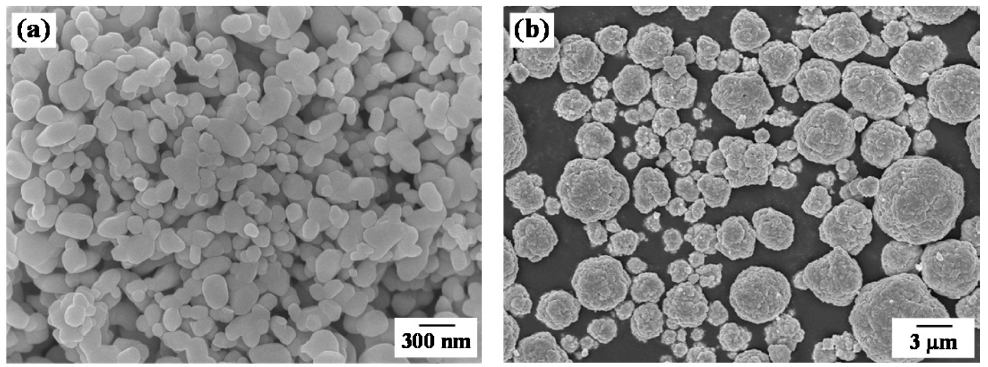
- 609 View
- 3 Download
-
 Abstract
Abstract
 PDF
PDF Porous Cu-14 wt% Co with aligned pores is produced by a freeze drying and sintering process. Unidirectional freezing of camphene slurry with CuO-Co3O4 powders is conducted, and pores in the frozen specimens are generated by sublimation of the camphene crystals. The dried bodies are hydrogen-reduced at 500°C and sintered at 800°C for 1 h. The reduction behavior of the CuO-Co3O4 powder mixture is analyzed using a temperature-programmed reduction method in an Ar-10% H2 atmosphere. The sintered bodies show large and aligned parallel pores in the camphene growth direction. In addition, small pores are distributed around the internal walls of the large pores. The size and fraction of the pores decrease as the amount of solid powder added to the slurry increases. The change in pore characteristics according to the amount of the mixed powder is interpreted to be due to the rearrangement and accumulation behavior of the solid particles in the freezing process of the slurry.
- [Korean]
- Microstructures and Characterization of Al-Si-Mg Alloy Processed by Selective Laser Melting with Post-Heat-treatment
- Gi Seung Lee, Yeong Seong Eom, Kyung Tae Kim, Byoung Kee Kim, Ji Hun Yu
- J Korean Powder Metall Inst. 2019;26(2):138-145. Published online April 1, 2019
- DOI: https://doi.org/10.4150/KPMI.2019.26.2.138

- 1,343 View
- 11 Download
- 3 Citations
-
 Abstract
Abstract
 PDF
PDF In this study, Al-Si-Mg alloys are additively manufactured using a selective laser melting (SLM) process from AlSi10Mg powders prepared from a gas-atomization process. The processing parameters such as laser scan speed and laser power are investigated for 3D printing of Al-Si-Mg alloys. The laser scan speeds vary from 100 to 2000 mm/s at the laser power of 180 and 270W, respectively, to achieve optimized densification of the Al-Si-Mg alloy. It is observed that the relative density of the Al-Si-Mg alloy reaches a peak value of 99% at 1600 mm/s for 180W and at 2000 mm/s for 270W. The surface morphologies of the both Al-Si-Mg alloy samples at these conditions show significantly reduced porosities compared to those of other samples. The increase in hardness of as-built Al-Si-Mg alloy with increasing scan speed and laser power is analyzed due to high relative density. Furthermore, it was found that cooling conditions after the heat-treatment for homogenization results in the change of dispersion status of Si phases in the Al-Si matrix but also affects tensile behaviors of Al-Si-Mg alloys. These results indicate that combination between SLM processing parameters and post-heat treatment should be considered a key factor to achieve optimized Al-Si alloy performance.
-
Citations
Citations to this article as recorded by- Fabrication and mechanical properties of Al–Si-based alloys by selective laser melting process
Yeong Seong Eom, Kyung Tae Kim, Dong Won Kim, Soo ho Jung, Jung Woo Nam, Dong Yeol Yang, Jungho Choe, Ji Hun Yu, Injoon Son
Powder Metallurgy.2021; 64(3): 198. CrossRef - Investigation on Interfacial Microstructures of Stainless Steel/Inconel Bonded by Directed Energy Deposition of alloy Powders
Yeong Seong Eom, Kyung Tae Kim, Soo-Ho Jung, Jihun Yu, Dong Yeol Yang, Jungho Choe, Chul Yong Sim, Seung Jun An
Journal of Korean Powder Metallurgy Institute.2020; 27(3): 219. CrossRef - Influence of Powder Size on Properties of Selectively Laser-Melted- AlSi10Mg Alloys
Yeong Seong Eom, Dong Won Kim, Kyung Tae Kim, Sang Sun Yang, Jungho Choe, Injoon Son, Ji Hun Yu
Journal of Korean Powder Metallurgy Institute.2020; 27(2): 103. CrossRef
- Fabrication and mechanical properties of Al–Si-based alloys by selective laser melting process
- [Korean]
- A Study on the Preparation of Rare Earth Oxide Powder for Rare Earth Precipitates Recovered from Spent Ni-MH Batteries
- Dae-Weon Kim, Nak-Kyoon Ahn, Hyun-Woo Shim, Kyung-Soo Park, Hee-Lack Choi
- J Korean Powder Metall Inst. 2018;25(3):213-219. Published online June 1, 2018
- DOI: https://doi.org/10.4150/KPMI.2018.25.3.213
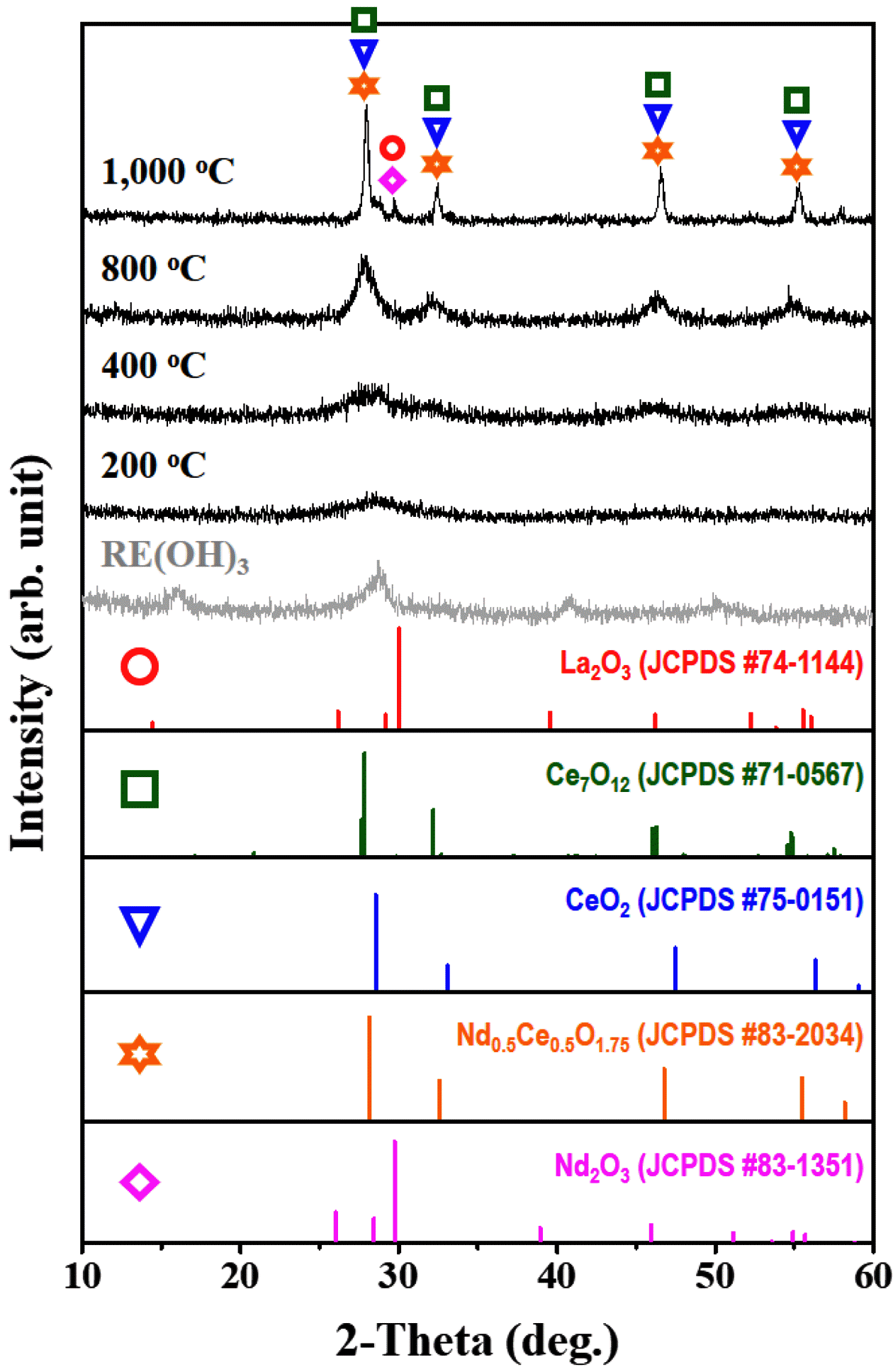
- 529 View
- 2 Download
- 2 Citations
-
 Abstract
Abstract
 PDF
PDF We report a method for preparing rare earth oxides (RexOy) from the recycling process for spent Ni-metal hydride (Ni-MH) batteries. This process first involves a leaching of spent Ni-MH powders with sulfuric acid at 90°C, resulting in rare earth precipitates (i.e., NaRE(SO4)2·H2O, RE = La, Ce, Nd), which are converted into rare earth oxides via two different approaches: i) simple heat treatment in air, and ii) metathesis reaction with NaOH at 70°C. Not only the morphological features but also the crystallographic structures of all products are systematically investigated using field-emission scanning electron microscopy (FESEM) and X-ray diffraction (XRD); their thermal behaviors are also analyzed. In particular, XRD results show that some of the rare earth precipitates are converted into oxide form (such as La2O3, Ce2O3, and Nd2O3) with heat treatment at 1200°C; however, secondary peaks are also observed. On the other hand, rare earth oxides, RexOy can be successfully obtained after metathesis of rare earth precipitates, followed by heat treatment at 1000°C in air, along with a change of crystallographic structures, i.e., NaRE(SO4)2·H2O → RE(OH)3 →RexOy.
-
Citations
Citations to this article as recorded by- Recycling of Rechargeable Batteries: Insights from a Bibliometrics‐Based Analysis of Emerging Publishing and Research Trends
Jiao Lin, Xiaodong Zhang, Li Cai, Ersha Fan, Shumeng Wu, Su Ma, Feng Wu, Renjie Chen, Li Li
Advanced Energy and Sustainability Research.2022;[Epub] CrossRef -
Synthesis of Rare Earth Oxide from NaREE(SO4)2·H2O by Ion Substitution Reaction
Dae-Weon Kim, Bo-Ram Kim, Hee-Lack Choi
Journal of the Korean Society of Mineral and Energy Resources Engineers.2020; 57(5): 405. CrossRef
- Recycling of Rechargeable Batteries: Insights from a Bibliometrics‐Based Analysis of Emerging Publishing and Research Trends
- [English]
- Solid-state sintering mechanism of blended elemental Ti-6Al-4V powders
- Youngmoo Kim, Young-Beom Song, Sung Ho Lee
- J Korean Powder Metall Inst. 2018;25(2):109-119. Published online April 1, 2018
- DOI: https://doi.org/10.4150/KPMI.2017.25.2.109
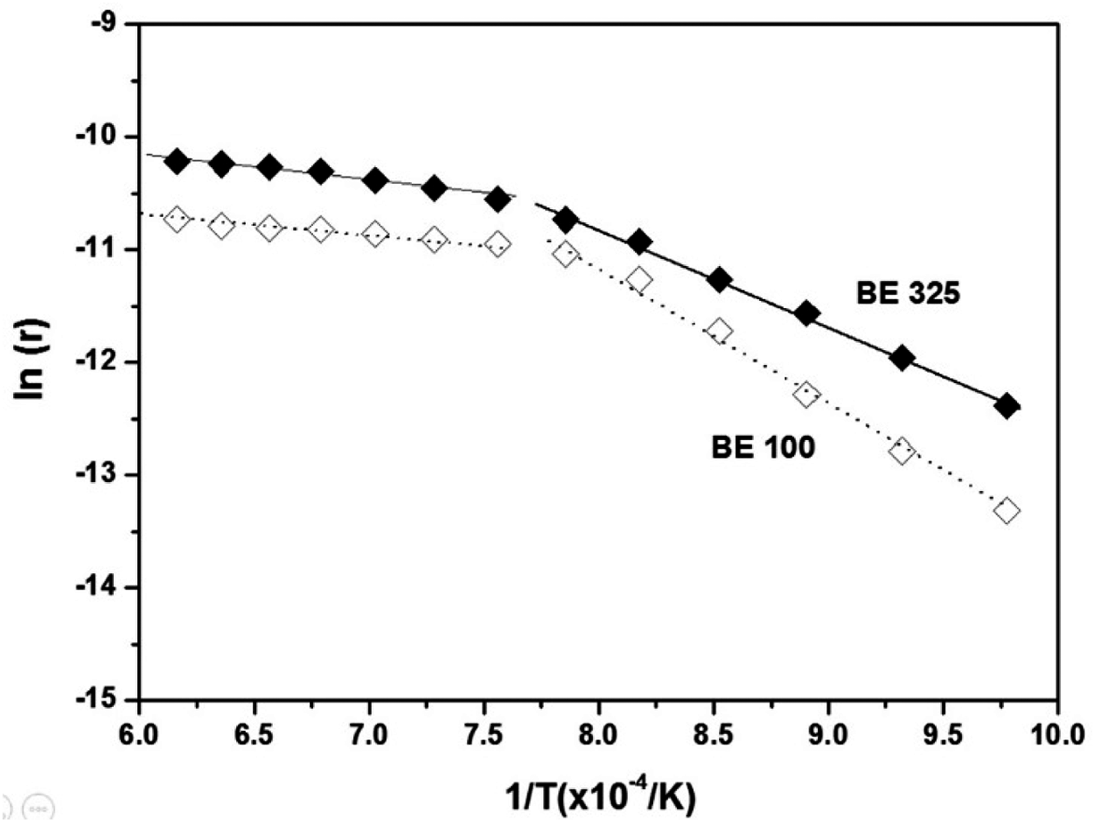
- 766 View
- 8 Download
-
 Abstract
Abstract
 PDF
PDF The objective of this study is to reveal the sintering mechanism of mixed Ti-6Al-4V powders considering the densification and the homogenization between Ti and Al/V particles. It is found that the addition of master alloy particles into Ti enhances densification by the migration of Al into the Ti matrix prior to the self-diffusion of Ti. However, as Ti particles become coarser, sintering of the powders appears to be retarded due to slower inter-diffusion of the particles due to the reduced surface energies of Ti. Such phenomena are confirmed by a series of dilatometry tests and microstructural analyses in respect to the sintering temperature. Furthermore, the results are also consistent with the predicted activation energies for sintering. The energies are found to have decreased from 299.35 to 135.48 kJ·mol-1 by adding the Al/V particles because the activation energy for the diffusion of Al in α-Ti (77 kJ·mol-1) is much lower than that of the self-diffusion of α-Ti. The coarser Ti powders increase the energies from 135.48 to 181.16 kJ·mol-1 because the specific surface areas of Ti decrease.
- [English]
- Fabrication of Core-Shell Structured Ni-Based Alloy Nanopowder by Electrical Wire Explosion Method
- A-Young Lee, Gwang-Yeob Lee, Hye-Ryeong Oh, Hyeon-Ah Kim, Song-Yi Kim, Min-Ha Lee
- J Korean Powder Metall Inst. 2016;23(6):409-413. Published online December 1, 2016
- DOI: https://doi.org/10.4150/KPMI.2016.23.6.409
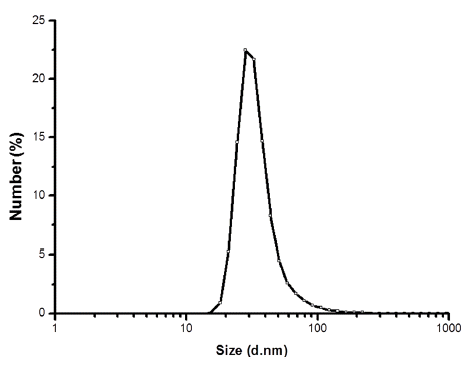
- 700 View
- 1 Download
-
 Abstract
Abstract
 PDF
PDF Electrical wire explosion in liquid media is a promising method for producing metallic nanopowders. It is possible to obtain high-purity metallic nanoparticles and uniform-sized nanopowder with excellent dispersion stability using this electrical wire explosion method. In this study, Ni-Fe alloy nanopowders with core-shell structures are fabricated via the electrical explosion of Ni-Fe alloy wires 0.1 mm in diameter and 20 mm in length in de-ionized water. The size and shape of the powders are investigated by field-emission scanning electron microscopy, transmission electron microscopy, and laser particle size analysis. Phase analysis and grain size determination are conducted by X-ray diffraction. The result indicate that a core-shell structured Ni-Fe nanopowder is synthesized with an average particle size of approximately 28 nm, and nanosized Ni core particles are encapsulated by an Fe nanolayer.
- [Korean]
- Investigation on Fe-Hf-B-Nb-P-C Soft Magnetic Powders Prepared by High-Pressure Gas Atomization
- Jae Won Jeong, Dong-Yeol Yang, Ki Bong Kim, Junhong Lee, Young Ja Kim, Tae-Soo Lim, Sangsun Yang, Min Ha Lee, Hwi Jun Kim, Yong-Jin Kim
- J Korean Powder Metall Inst. 2016;23(5):391-396. Published online October 1, 2016
- DOI: https://doi.org/10.4150/KPMI.2016.23.5.391
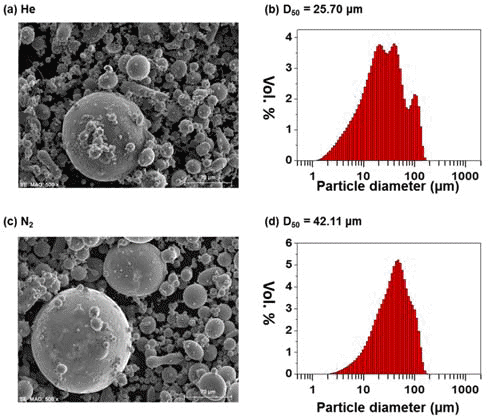
- 695 View
- 1 Download
- 3 Citations
-
 Abstract
Abstract
 PDF
PDF In this study, ultra-fine soft-magnetic micro-powders are prepared by high-pressure gas atomization of an Fe-based alloy, Fe-Hf-B-Nb-P-C. Spherical powders are successfully obtained by disintegration of the alloy melts under high-pressure He or N2 gas. The mean particle diameter of the obtained powders is 25.7 μm and 42.1 μm for He and N2 gas, respectively. Their crystallographic structure is confirmed to be amorphous throughout the interior when the particle diameter is less than 45 μm. The prepared powders show excellent soft magnetic properties with a saturation magnetization of 164.5 emu/g and a coercivity of 9.0 Oe. Finally, a toroidal core is fabricated for measuring the magnetic permeability, and a μr of up to 78.5 is obtained. It is strongly believed that soft magnetic powders prepared by gas atomization will be beneficial in the fabrication of high-performance devices, including inductors and motors.
-
Citations
Citations to this article as recorded by- Optimization of Densification Behavior of a Soft Magnetic Powder by Discrete Element Method and Machine Learning
Jungjoon Kim, Dongchan Min, Suwon Park, Junhyub Jeon, Seok-Jae Lee, Youngkyun Kim, Hwi-Jun Kim, Youngjin Kim, Hyunjoo Choi
MATERIALS TRANSACTIONS.2022; 63(10): 1304. CrossRef - Optimizing the magnetic properties of Fe-based amorphous powder by adjusting atomic structures from vitrification at different temperatures
Song-Yi Kim, Hye-Ryeong Oh, Hyeon-Ah Kim, A-Young Lee, Hwi-Jun Kim, Sang-Sun Yang, Yong-Jin Kim, Hyun-Joo Choi, Il-Hyun Kim, Hyun-Gil Kim, Jürgen Eckert, Jong-Ryoul Kim, Min-Ha Lee
Journal of Applied Physics.2019;[Epub] CrossRef - Soft magnetic properties of Fe-based amorphous/nanocrystalline hybrid materials
Yeonjoo Lee, Jonggyu Jeon, Seungjin Nam, Teasuk Jang, Hwijun Kim, Minwoo Lee, Yongjin Kim, Dongyeol Yang, Kyeongsik Min, Hyunjoo Choi
Powder Technology.2018; 339: 440. CrossRef
- Optimization of Densification Behavior of a Soft Magnetic Powder by Discrete Element Method and Machine Learning
- [Korean]
- Synthesis of Nickel Nanoparticle-adsorbed Aluminum Powders for Energetic Applications
- Dong Won Kim, Gu Hyun Kwon, Kyung Tae Kim
- J Korean Powder Metall Inst. 2016;24(3):242-247. Published online June 1, 2016
- DOI: https://doi.org/10.4150/KPMI.2017.24.3.242

- 1,028 View
- 8 Download
- 8 Citations
-
 Abstract
Abstract
 PDF
PDF In this study, the electroless nickel plating method has been investigated for the coating of Ni nanoparticles onto fine Al powder as promising energetic materials. The adsorption of nickel nanoparticles onto the surface of Al powders has been studied by varying various process parameters, namely, the amounts of reducing agent, complexing agent, and pH-controller. The size of nickel nanoparticles synthesized in the process has been optimized to approximately 200 nm and they have been adsorbed on the Al powder. TGA results clearly show that the temperature at which oxidation of Al mainly occurs is lowered as the amount of Ni nanoparticles on the Al surface increases. Furthermore, the Ni-plated Al powders prepared for all conditions show improved exothermic reaction due to the selfpropagating high-temperature synthesis (SHS) between Ni and Al. Therefore, Al powders fully coated by Ni nanoparticles show the highest exothermic reactivity: this demonstrates the efficiency of Ni coating in improving the energetic properties of Al powders.
-
Citations
Citations to this article as recorded by- Synthesis and oxidation behavior of Al@Ni-Fe core-shell energetic composite powders
Khawar Yaqoob, Asifa Kusar, Amena Mohsin, Onur Ertuğrul, Ahmet Çağrı Kılınç, Fahad Ali, Rub Nawaz Shahid, Naeem ul Haq Tariq, Hassan Wahab, Hasan Bin Awais
Energetic Materials Frontiers.2025;[Epub] CrossRef - Study Progress in Improving the Energy Release Rate of Al Powders
永鹏 陈
Material Sciences.2024; 14(08): 1178. CrossRef - Study on the Combustion Characteristics of Ethanol Nanofuel
Kwanyoung Noh, Hyemin Kim, Siwook Nam, Soonho Song
Aerospace.2023; 10(10): 878. CrossRef - The Self-Reduction during the Thermal Decomposition of an Ammonium Molybdate
Kyoungkeun Yoo, Won Beom Koo, Hanggoo Kim, Sang-hun Lee
Minerals.2023; 13(2): 133. CrossRef - Increased exothermic reactivity of polytetrafluoroethylene-coated aluminum powders: Impact of powder size reduction
Soo-ho Jung, Kyung Tae Kim, Jinhee Bae, Yoon Jeong Choi, Jae Min Kim, Jeong-Yun Sun
Materials Letters.2023; 351: 135009. CrossRef - High energy Al@Ni preparation of core-shell particles by adjusting nickel layer thickness
Yongpeng Chen, Jianguo Zhang, Jiawei Zhu, Ning Xiang, Huichao Zhang, Zunning Zhou
Vacuum.2022; 205: 111344. CrossRef - Electroless deposition of Ni nanoparticles on micron-sized boron carbide particles: Physicochemical and oxidation properties
Prashant Ravasaheb Deshmukh, Hyung Soo Hyun, Youngku Sohn, Weon Gyu Shin
Korean Journal of Chemical Engineering.2020; 37(3): 546. CrossRef - Synthesis and exothermic reactions of ultra-fine snowman-shaped particles with directly bonded Ni/Al interfaces
Gu Hyun Kwon, Kyung Tae Kim, Dong Won Kim, Jungho Choe, Jung Yeul Yun, Jong-Man Kim
Applied Surface Science.2019; 476: 481. CrossRef
- Synthesis and oxidation behavior of Al@Ni-Fe core-shell energetic composite powders
- [Korean]
- Mechanical Property Improvement of the H13 Tool Steel Sculptures Built by Metal 3D Printing Process via Optimum Conditions
- Jaecheol Yun, Jungho Choe, Haengna Lee, Ki-Bong Kim, Sangsun Yang, Dong-Yeol Yang, Yong-Jin Kim, Chang-Woo Lee, Ji-Hun Yu
- J Korean Powder Metall Inst. 2016;24(3):195-201. Published online June 1, 2016
- DOI: https://doi.org/10.4150/KPMI.2017.24.3.195
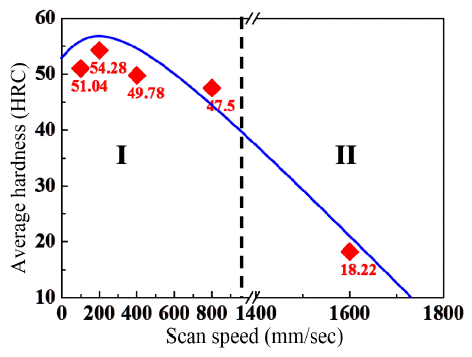
- 1,037 View
- 10 Download
- 7 Citations
-
 Abstract
Abstract
 PDF
PDF In this study, H13 tool steel sculptures are built by a metal 3D printing process at various laser scan speeds. The properties of commercial H13 tool steel powders are confirmed for the metal 3D printing process used: powder bed fusion (PBF), which is a selective laser melting (SLM) process. Commercial H13 powder has an excellent flowability of 16.68 s/50 g with a Hausner ratio of 1.25 and a density of 7.68 g/cm3. The sculptures are built with dimensions of 10 × 10 × 10 mm3 in size using commercial H13 tool steel powder. The density measured by the Archimedes method is 7.64 g/cm3, similar to the powder density of 7.68 g/cm3. The hardness is measured by Rockwell hardness equipment 5 times to obtain a mean value of 54.28 HRC. The optimum process conditions in order to build the sculptures are a laser power of 90 W, a layer thickness of 25 μm, an overlap of 30%, and a laser scan speed of 200 mm/s.
-
Citations
Citations to this article as recorded by- Spheroidization of Enamel Powders by Radio Frequency Plasma Treatment and Application to Additive Manufacturing
Ki-Bong Kim, Dong-Yeol Yang, Yong-Jin Kim, Jungho Choe, Ji-Na Kwak, Woo-Hyung Jung
Journal of Korean Powder Metallurgy Institute.2020; 27(5): 388. CrossRef - Microstructural effects on the tensile and fracture behavior of selective laser melted H13 tool steel under varying conditions
Jungsub Lee, Jungho Choe, Junhyeok Park, Ji-Hun Yu, Sangshik Kim, Im Doo Jung, Hyokyung Sung
Materials Characterization.2019; 155: 109817. CrossRef - Nano-mechanical Behavior of H13 Tool Steel Fabricated by a Selective Laser Melting Method
Van Luong Nguyen, Eun-ah Kim, Jaecheol Yun, Jungho Choe, Dong-yeol Yang, Hak-sung Lee, Chang-woo Lee, Ji-Hun Yu
Metallurgical and Materials Transactions A.2019; 50(2): 523. CrossRef - Correlation between Microstructure and Mechanical Properties of the Additive Manufactured H13 Tool Steel
Woojin An, Junhyeok Park, Jungsub Lee, Jungho Choe, Im Doo Jung, Ji-Hun Yu, Sangshik Kim, Hyokyung Sung
Korean Journal of Materials Research.2018; 28(11): 663. CrossRef - Evaluation of Strain-Rate Sensitivity of Selective Laser Melted H13 Tool Steel Using Nanoindentation Tests
Van Luong Nguyen, Eun-ah Kim, Seok-Rok Lee, Jaecheol Yun, Jungho Choe, Dong-yeol Yang, Hak-sung Lee, Chang-woo Lee, Ji-Hun Yu
Metals.2018; 8(8): 589. CrossRef - Comparison of Nano-Mechanical Behavior between Selective Laser Melted SKD61 and H13 Tool Steels
Jaecheol Yun, Van Luong Nguyen, Jungho Choe, Dong-Yeol Yang, Hak-Sung Lee, Sangsun Yang, Ji-Hun Yu
Metals.2018; 8(12): 1032. CrossRef - A study about sculpture characteristic of SKD61 tool steel fabricated by selective laser melting(SLM) process
Jaecheol Yun, Jungho Choe, Ki-Bong Kim, Sangsun Yang, Dong-Yeol Yang, Yong-Jin Kim, Chang-Woo Lee, Chang-Woo Lee
Journal of Korean Powder Metallurgy Institute.2018; 25(2): 137. CrossRef
- Spheroidization of Enamel Powders by Radio Frequency Plasma Treatment and Application to Additive Manufacturing
- [English]
- Influences of the Eu Concentration and the Milling Time on Photoluminescence Properties of Y2O3-H3BO3:Eu3+ Powders Prepared by Mechanical Alloying
- Hyun-Sic Gong, Hyun-Goo Kim
- J Korean Powder Metall Inst. 2016;23(2):108-111. Published online April 1, 2016
- DOI: https://doi.org/10.4150/KPMI.2016.23.2.108
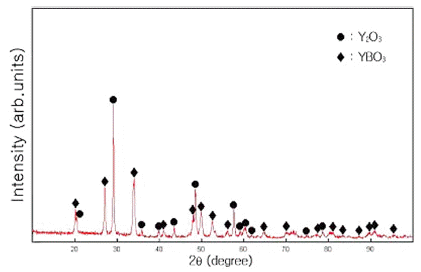
- 521 View
- 3 Download
-
 Abstract
Abstract
 PDF
PDF Y2O3–H3BO3:Eu3+ powders are synthesized using a mechanical alloying method, and their photoluminescence (PL) properties are investigated through luminescence spectrophotometry. For samples milled for 300 min, some Y2O3 peaks ([222], [440], and [622]) and amorphous formations are observed. The 300-min-milled mixture annealed at 800°C for 1 h with Eu = 8 mol% has the strongest PL intensity at every temperature increase of 100°C (increasing from 700 to 1200°C in 100°C increments). PL peaks of the powder mixture, as excited by a xenon discharge lamp (20 kW) at 240 nm, are detected at approximately 592 nm (orange light, 5Do → 7F1), 613 nm, 628 nm (red light, 5Do → 7F1), and 650 nm. The PL intensity of powder mixtures milled for 120 min is generally lower than that of powder mixtures milled for 300 min under the same conditions. PL peaks due to YBO3 and Y2O3 are observed for 300-min-milled Y2O3–H3BO3 with Eu = 8 mol% after annealing at 800°C for 1 h.
- [Korean]
- Synthesis of Pt@TiO2 Nano-composite via Photochemical Reduction Method
- Ji Young Kim, Jong Min Byun, Jin Woo Kim, Young Do Kim
- J Korean Powder Metall Inst. 2014;21(2):119-123. Published online April 1, 2014
- DOI: https://doi.org/10.4150/KPMI.2014.21.2.119
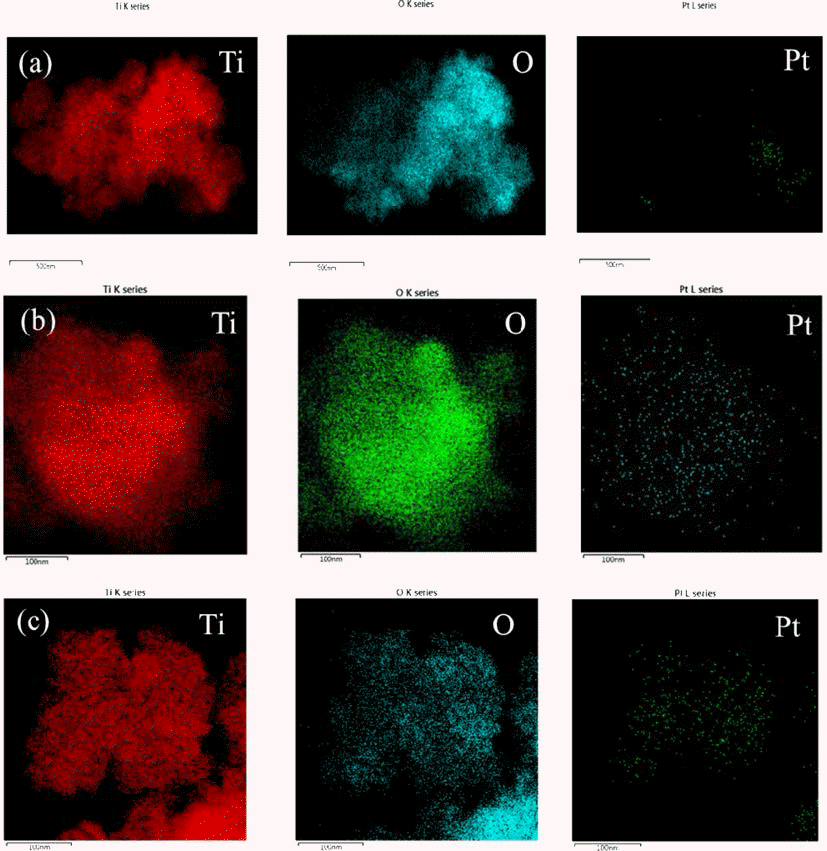
- 653 View
- 2 Download
- 2 Citations
-
 Abstract
Abstract
 PDF
PDF Pt has been widely used as catalyst for fuel cell and exhausted gas clean systems due to its high catalytic activity. Recently, there have been researches on fabricating composite materials of Pt as a method of reducing the amount of Pt due to its high price. One of the approaches for saving Pt used as catalyst is a core shell structure consisting of Pt layer on the core of the non-noble metal. In this study, the synthesis of Pt shell was conducted on the surface of TiO2 particle, a non-noble material, by applying ultraviolet (UV) irradiation. Anatase TiO2 particles with the average size of 20~30 nm were immersed in the ethanol dissolved with Pt precursor of H2PtCl6∙6H2O and exposed to UV irradiation with the wavelength of 365 nm. It was confirmed that Pt nano-particles were formed on the surface of TiO2 particles by photochemical reduction of Pt ion from the solution. The morphology of the synthesized Pt@TiO2 nano-composite was examined by TEM (Transmission Electron Microscopy).
-
Citations
Citations to this article as recorded by- Photocatalytic activity of rutile TiO2 powders coupled with anatase TiO2 nanoparticles using surfactant
Jong Min Byun, Chun Woong Park, Young In Kim, Young Do Kim
journal of Korean Powder Metallurgy Institute.2018; 25(3): 257. CrossRef - Synthesis and Photo Catalytic Activity of 10 wt%, 20 wt%Li-TiO2 Composite Powders
Hyeong-Chul Kim, Jae-Kil Han
Journal of Korean Powder Metallurgy Institute.2016; 23(1): 33. CrossRef
- Photocatalytic activity of rutile TiO2 powders coupled with anatase TiO2 nanoparticles using surfactant
TOP
 KPMI
KPMI


 First
First Prev
Prev


